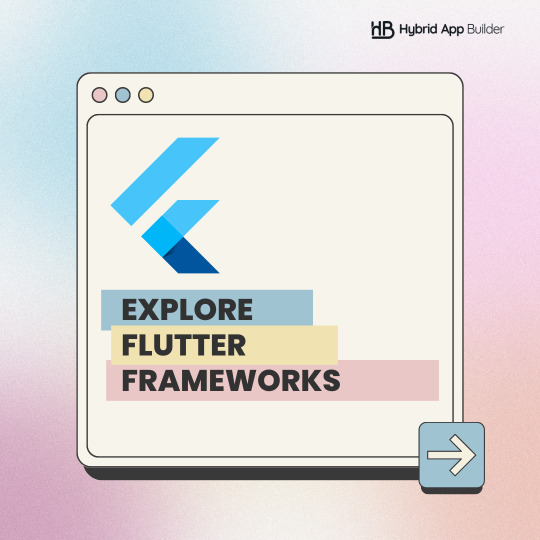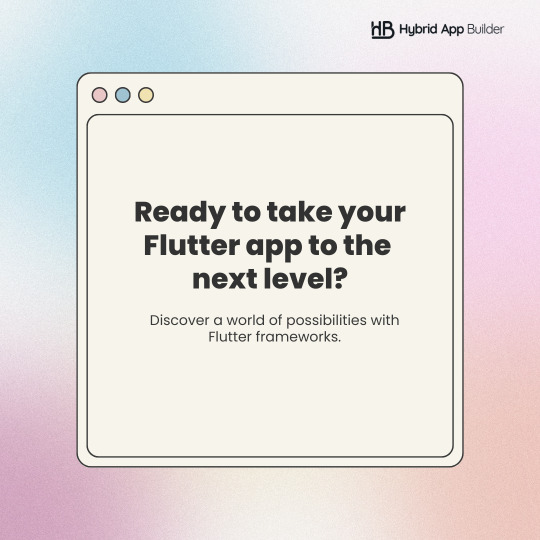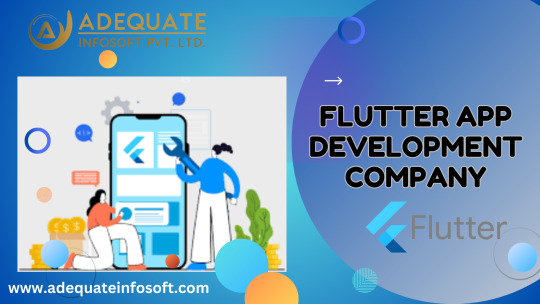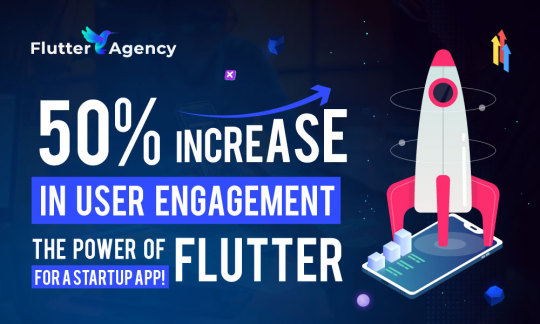#Flutter Development
Explore tagged Tumblr posts
Text







🚀 Ready to take your Flutter development to the next level?
🔥 Check out our top picks for Flutter frameworks and take your app to new heights! 📱
3 notes
·
View notes
Text

Welcome to Adequate Infosoft, your premier destination for Flutter app development solutions. We are a cutting-edge software development company specializing in creating high-quality and innovative mobile applications using Flutter, the popular cross-platform framework developed by Google.
2 notes
·
View notes
Text
How XcelTec Can Help With Best Flutter App Development Services?

Cross-platform app development tool Flutter helps developers balance productivity and quality. Applications developed for mobile platforms using Flutter provide a number of benefits and accelerate application development. A few key components in the development of Flutter applications are listed below:
Single-Based Coding
Broad Widget Library
Upgraded User Experience
Material Design and Cupertino
Dart Advantages
Best Flutter App Development Services by XcelTec;
As the leading provider of Flutter app development services, XcelTec offers a range of Flutter App Development offerings that have aided clients all over the world in reaching the zenith of their development. Our unrivalled and incredibly dependable Flutter application engineers assist companies in creating cross-platform native interfaces of the highest calibre.
We fully utilise the advancing technology to provide a WOW experience. Additionally, we promise that the most skilled Flutter developers will support your application with the best work available in the industry. To have a lasting impact on our knowledgeable, existing clients, we provide a unique range of Flutter app development features, which include:
UI/UX Design
Dart App Development
Flutter Development for iOS and Android
Front-end and Backend Development
Flutter Cross-platform Development
Testing and QA Solutions
Application Migration and support
Visit to explore more on How XcelTec Can Help You With The Best Flutter App Development Services?
Get in touch with us for more!
Contact us on:- +91 987 979 9459 | +1 919 400 9200
Email us at:- [email protected]
#flutter app development#flutter app development company#flutter app#flutter development#flutter development services#hire mobile app developer
2 notes
·
View notes
Text
0 notes
Text
Innovative Flutter Development for Seamless Apps
CodePerk Solutions brings your app ideas to life with expert Flutter development. Based in Ahmedabad with offices in the USA, UK, and Canada, we leverage Flutter’s powerful framework to create high-performance, cross-platform applications. Our skilled developers ensure your apps deliver stunning visuals and smooth functionality across iOS and Android. With a focus on efficiency and customization, our Flutter development services save time and costs while maintaining quality. Trust us to transform your vision into reality with cutting-edge solutions.
0 notes
Text
Best Cross-Platform App Development Frameworks

In today’s fast-paced digital world, businesses need to reach users on multiple platforms without excessive development costs. Cross-platform app development has emerged as the perfect solution, allowing developers to write a single codebase and deploy it across iOS, Android, and even web applications.
But with so many frameworks available, how do you choose the right one?
In this guide, we’ll explore the best cross-platform app development frameworks of 2025, their benefits, key features, and how they compare in terms of performance, scalability, and cost-effectiveness. Whether you’re a startup looking for a quick MVP or an enterprise aiming for a seamless multi-platform experience, this guide will help you make an informed decision.
What is a Cross-Platform App Development Framework?
A Cross-Platform App Development Framework is a software tool that enables developers to create mobile applications that run on multiple operating systems (iOS, Android, Windows) using a single codebase. Unlike native development, which requires separate coding for different platforms, cross-platform frameworks streamline the process, reducing development time and costs.
What Are the Benefits of Cross-Platform App Development Frameworks?
1. Code Reusability: Write Once, Run Anywhere
One of the most significant advantages of cross-platform development is code reusability. Instead of writing separate codebases for iOS and Android, developers can create a single codebase that works across multiple platforms. This approach:
Reduces development time by eliminating redundant coding efforts.
Simplifies debugging and maintenance, as there is only one codebase to manage.
Ensures consistency in application logic and functionality across all platforms.
Boosts efficiency, allowing developers to focus on innovation rather than rewriting code.
2. Cost-Effective: Reduce Development and Maintenance Costs
Developing separate native apps for Android and iOS requires two development teams, doubling costs. With cross-platform frameworks:
Businesses save money by hiring a single development team instead of two.
Maintenance costs are lower since updates and bug fixes are applied universally to all platforms.
Faster development cycles lead to quicker product launches, reducing time-to-market expenses.
Startups and SMEs benefit from budget-friendly app development without compromising performance.
3. Faster Development: Quick Deployment Across Multiple Platforms
Time-to-market is crucial in today’s competitive landscape. Cross-platform frameworks enable rapid development by:
Using pre-built components and libraries, which speed up the development process.
Allowing simultaneous deployment on different platforms reduces the time required to launch an app.
Supporting features like Hot Reload (Flutter) and Live Reload (React Native), which enable instant updates and real-time testing.
Enhancing developer productivity, leading to shorter development cycles and faster iterations.
4. Uniform User Experience: Maintain UI/UX Consistency
Cross-platform development ensures a seamless and consistent user experience across all devices. This is crucial for brand recognition and customer satisfaction. Benefits include:
Consistent UI elements, ensuring a uniform look and feel across all platforms.
Frameworks like Flutter and React Native provide platform-specific UI components, making apps feel native.
Improved user engagement and retention due to a familiar and intuitive interface.
Eliminates the risk of disjointed user experiences caused by inconsistent design on different operating systems.
5. Wider Market Reach: Launch Apps on Different OS Simultaneously
Cross-platform development allows businesses to reach a larger audience by launching applications on multiple operating systems at once. This results in:
Increased customer base, as apps are available to both iOS and Android users simultaneously.
Higher revenue potential, as businesses don’t miss out on either market segment.
Scalability, enabling future expansion to platforms like Windows, macOS, and Web with minimal effort.
A competitive edge, as businesses can launch faster than those relying on traditional native app development.
What Are the Best Frameworks for Developing Cross-Platform Mobile Apps?
1. Flutter
Developer: Google
Language: Dart
Why Choose Flutter?
Flutter, developed by Google, is one of the most popular cross-platform app development frameworks. It is known for its fast development, high-performance rendering, and visually appealing UI components. Flutter allows developers to build natively compiled applications for mobile, web, and desktop using a single codebase.
Hot Reload: One of Flutter’s standout features is Hot Reload, which enables developers to see code changes instantly without restarting the application. This accelerates the development process and enhances productivity.
Rich UI Components: Flutter offers a comprehensive widget-based architecture, allowing developers to create visually rich and customizable UI components that provide a native-like experience.
High Performance: The framework uses Skia, a powerful 2D rendering engine, to deliver smooth animations and seamless performance.
Strong Community Support: Being backed by Google, Flutter has extensive documentation, active developer communities, and continuous updates that keep it evolving.
Use Cases:
Flutter is widely used for:
MVP (Minimum Viable Product) Development: Ideal for startups looking to validate their ideas quickly.
eCommerce Apps: Provides a smooth and responsive user experience for online shopping platforms.
On-Demand Service Apps: Used for apps like ride-hailing, food delivery, and home services due to its fast rendering and interactive UI.
Popular Apps Built with Flutter:
Google Ads — A mobile version of Google’s advertising platform.
BMW App — The automobile giant’s mobile application for seamless customer engagement.
Alibaba — A widely used eCommerce app leveraging Flutter for a dynamic user experience.
2. React Native
Developer: Meta (formerly Facebook)
Language: JavaScript
Why Choose React Native?
React Native is an open-source JavaScript framework developed by Meta (formerly Facebook). It is one of the most widely used cross-platform frameworks, known for its efficiency, reusability, and fast development cycle.
Reusable Components: Developers can write once and reuse components across both Android and iOS platforms, reducing development time and cost.
Live Reload: Similar to Flutter’s Hot Reload, React Native offers Live Reload, which enables developers to see the impact of their code changes instantly.
Strong Community Support: With Meta’s backing, React Native enjoys an active open-source community, providing extensive libraries, third-party plugins, and developer support.
Third-Party Plugin Support: The framework supports third-party modules, enhancing functionality and speeding up development.
Use Cases:
React Native is widely used for:
Social Media Apps: It powers apps like Facebook and Instagram due to its high performance and native-like UI.
Streaming Apps: Popular for building media and video streaming platforms like Netflix and YouTube.
FinTech Solutions: Provides security and seamless functionality for banking and financial applications.
Popular Apps Built with React Native:
Facebook — The company’s own app is built on React Native.
Instagram — A leading photo and video-sharing platform.
Airbnb — A global marketplace for travel and accommodation services.
3. Xamarin
Developer: Microsoft
Language: C#
Why Choose Xamarin?
Xamarin, developed by Microsoft, is a robust framework that allows developers to build native-like applications using C# and .NET. It is well-suited for enterprise applications that require seamless API integration and high performance.
Seamless API Integration: Xamarin provides direct access to native APIs, ensuring apps feel truly native while being built with a shared codebase.
Strong Microsoft Ecosystem: Developers can leverage Azure, Visual Studio, and .NET libraries to enhance functionality and performance.
Code Sharing: Up to 90% of the codebase can be shared across different platforms, significantly reducing development time.
Use Cases:
Xamarin is commonly used for:
Enterprise Applications: Many large organizations use Xamarin to create secure and scalable business applications.
Healthcare Apps: With a focus on performance and security, Xamarin is a preferred choice for healthcare and medical applications.
Financial Software: Due to its robust security features, Xamarin is used for banking and financial applications.
Popular Apps Built with Xamarin:
Microsoft Outlook — A widely used email and productivity application.
Alaska Airlines — A seamless flight booking and travel app.
The World Bank — A high-performance mobile solution for the financial sector.
4. Kotlin Multiplatform
Developer: JetBrains
Language: Kotlin
Why Choose Kotlin Multiplatform?
Kotlin Multiplatform, developed by JetBrains, is an emerging cross-platform framework that enables developers to use Kotlin’s native features while sharing code between Android, iOS, and web applications.
Native Performance: Unlike other frameworks that rely on JavaScript, Kotlin Multiplatform compiles native code, delivering high performance.
Flexible Architecture: Developers can write shared business logic while keeping platform-specific implementations for UI and other critical functions.
Officially Supported by Google: Since Google supports Kotlin for Android development, Kotlin Multiplatform is future-proof and integrates well with existing Android applications.
Use Cases:
Kotlin Multiplatform is best suited for:
Business Applications: Ideal for corporate and enterprise solutions that require multi-platform compatibility.
Data-Driven Apps: Used in applications that rely on analytics and big data.
Utility Apps: Well-suited for tools like task managers, note-taking apps, and scheduling apps.
Popular Apps Built with Kotlin Multiplatform:
Cash App — A widely used mobile payment service.
PlanGrid — A construction productivity tool for professionals.
5. Unity
Developer: Unity Technologies
Language: C#
Why Choose Unity?
Unity is a powerful cross-platform game development framework that allows developers to create immersive gaming experiences with high-quality graphics and real-time rendering.
Best for Game Development: Unity is the leading framework for 2D and 3D game development, offering advanced physics engines and rendering capabilities.
AR/VR Support: It integrates with ARKit (Apple) and ARCore (Google), making it the top choice for augmented and virtual reality applications.
Cross-Platform Compatibility: Unity supports mobile, PC, web, and even console gaming, providing extensive platform coverage.
Use Cases:
Unity is widely used for:
Gaming Apps: The go-to framework for both indie and AAA game developers.
AR/VR Applications: Used in training simulations, interactive marketing, and immersive experiences.
3D Simulations: Deployed in architecture, automotive, and industrial applications.
Popular Apps Built with Unity:
Pokémon GO — The globally popular AR-based game.
Angry Birds 2 — A sequel to the hit mobile game.
Call of Duty Mobile — A high-performance shooter game.
6. Ionic
Developer: Ionic Framework Team
Language: HTML, CSS, JavaScript (with Angular, React, or Vue)
Why Choose Ionic?
Ionic is a popular open-source framework for building cross-platform apps with a web-first approach. It leverages standard web technologies while providing a native-like experience.
UI Components Library: Comes with pre-built UI components that offer a native feel on both iOS and Android.
Supports Multiple JavaScript Frameworks: Works seamlessly with Angular, React, and Vue.
Capacitor for Native Access: Provides direct access to native APIs, making hybrid apps more powerful.
Use Cases:
Ionic is widely used for:
Progressive Web Apps (PWAs): Ideal for web apps that function like mobile applications.
Business and Enterprise Apps: Used for internal tools and customer-facing applications.
E-Learning Applications: Popular in education technology due to its modularity.
Popular Apps Built with Ionic:
MarketWatch — A financial news and stock market tracking app.
Sworkit — A home workout and fitness app.
Sanvello — A mental health and wellness application.
How to Choose the Right Cross-Platform App Development Framework?
Selecting the right framework depends on various factors. Consider the following before making your decision:
1. Project Requirements
Different frameworks cater to different types of applications. If your app requires complex UI, high performance, or custom native integrations, opt for Flutter or Kotlin Multiplatform. For business apps requiring a stable ecosystem, Xamarin is a solid choice.
2. Development Language
Your team’s expertise in a particular programming language influences framework selection:
If you prefer Dart, go with Flutter.
For JavaScript developers, React Native is the best option.
C# developers should choose Xamarin.
If your team is experienced in Kotlin, Kotlin Multiplatform is ideal.
3. Performance Needs
For applications requiring smooth animations, complex UI interactions, and high-performance graphics, Flutter or Kotlin Multiplatform is the best choice. Unity is preferred for gaming and AR/VR apps due to its advanced rendering engine.
4. Community & Support
A strong developer community ensures better documentation, frequent updates, and troubleshooting support. React Native and Flutter have the largest communities, making them excellent choices for long-term scalability.
5. Cost Efficiency
Choosing the right framework also impacts development and maintenance costs. React Native and Flutter are widely used, meaning a larger talent pool and lower hiring costs. Xamarin, being a Microsoft product, is more cost-effective for enterprises already using the Microsoft ecosystem.
Why Choose CodeRower for Cross-Platform App Development?
At CodeRower, we specialize in delivering top-tier cross-platform mobile applications tailored to your business needs. Our expert developers leverage cutting-edge technologies to create seamless, high-performance apps that run smoothly across multiple platforms. Here’s why businesses trust us:
Expert Developers: Our team is proficient in leading cross-platform frameworks, including Flutter, React Native, and Xamarin.
Faster Time-to-Market: We use pre-built components, efficient coding practices, and agile methodologies to accelerate app development.
Cost-Effective Solutions: With a single codebase, we reduce development and maintenance costs without compromising quality.
Seamless UI/UX Design: We ensure consistent branding, intuitive interfaces, and engaging user experiences across all devices.
Scalability & Performance: Our applications are built to handle growing user bases with robust architecture and optimized performance.
Whether you need an MVP for your startup or an enterprise-grade solution, CodeRower provides end-to-end cross-platform app development services that drive business success.
Conclusion
Cross-platform app development has revolutionized the way businesses create mobile applications. Whether you prioritize UI, performance, or cost-effectiveness, choosing the right framework can significantly impact your app’s success.
CodeRower is a leading software development company specializing in cross-platform app development that helps businesses build high-performance applications for iOS, Android, and web using a single codebase. Our expert developers leverage Flutter, React Native, Xamarin, and Kotlin Multiplatform to create scalable, cost-effective, and feature-rich applications tailored to your business needs.
With a proven track record in delivering enterprise-grade applications, MVPs, and industry-specific solutions, CodeRower ensures seamless user experiences, optimized performance, and faster time-to-market.
If you’re looking for expert cross-platform app development services, CodeRower is here to help! Contact us today and bring your mobile app ideas to life.
Frequently Asked Questions
1. What is the difference between native and cross-platform app development?
Native app development involves building separate applications for each platform (iOS, Android) using platform-specific languages like Swift (iOS) and Kotlin (Android). Cross-platform app development, on the other hand, allows developers to write a single codebase that runs on multiple platforms, reducing development time and costs.
2. How does CodeRower help in cross-platform app development?
CodeRower specializes in developing high-quality, scalable cross-platform applications tailored to business needs. Our team of experts leverages cutting-edge technologies like Flutter, React Native, and Xamarin to deliver seamless, cost-effective solutions.
3. What are the key benefits of cross-platform app development?
Cross-platform app development offers several advantages, including:
Faster Development — A single codebase reduces development time.
Cost Efficiency — Saves resources compared to building separate native apps.
Wider Market Reach — Apps run on both iOS and Android simultaneously.
Easier Maintenance — Updates and bug fixes apply across platforms.
Consistent UI/UX — Ensures a uniform experience across devices.
4. What are some of the best cross-platform development frameworks?
Popular frameworks for cross-platform development include:
Flutter — Developed by Google, ideal for high-performance, visually rich apps.
React Native — Backed by Meta (Facebook), suitable for dynamic, fast apps.
Xamarin — A Microsoft-backed framework using C# and .NET.
Kotlin Multiplatform — Allows code sharing across iOS and Android.
5. How does CodeRower ensure a high-quality cross-platform app?
At CodeRower, we follow industry best practices to ensure top-notch app quality:
Agile Development — Rapid iterations for faster delivery.
Rigorous Testing — Performance, security, and usability testing.
Optimized Codebase — High performance with minimal latency.
User-Centric Design — Smooth navigation and engaging UI/UX.
Post-Launch Support — Regular updates and maintenance.
6. Why should I choose CodeRower for my cross-platform app development?
At CodeRower, we provide:
Expertise in multiple frameworks — Flutter, React Native, Xamarin, and Kotlin Multiplatform.
Custom-tailored solutions — Designed to fit your business requirements.
Scalability and performance — Apps optimized for speed, security, and efficiency.
Cost-effective development — Faster time-to-market without compromising quality.
Dedicated support — End-to-end maintenance and updates to keep your app running smoothly.
Ready to build your cross-platform app? 🚀 Contact CodeRower today to discuss your project requirements and take your business to the next level!
#development tools#framework#software development framework#agile framework#cross platform#flutter developers#flutter development#reactnative#reactjs developers#software development#app development#web app development#android app development#web development#ios app development#custom app development#game development#custom software development
0 notes
Text
Flutter Development
Flutter development is the process of building cross-platform applications using Google’s Flutter framework, enabling seamless performance on both iOS and Android from a single codebase. It combines speed, flexibility, and a rich UI toolkit to deliver visually stunning and high-performing apps.At Jiitak, we specialize in Flutter development, crafting fast, scalable, and feature-rich applications that provide a native-like experience across multiple platforms. Our team leverages Flutter’s robust capabilities to design and develop intuitive, high-quality mobile solutions that enhance user engagement and streamline business operations.
0 notes
Text
The Flutter Revolution: Progress and Innovation in the Last Three Years
This blog is about ,In three years, How Flutter has redefined cross-platform development with powerful tools, expanded platform support, and community-driven innovation.
https://kretoss.com/the-flutter-revolution-progress-and-innovation-in-the-last-three-years/

0 notes
Text
Flutter development companies are shaping the future of cross-platform app creation in 2025. These top 11 companies excel in providing scalable, innovative, and cost-effective solutions, making them the ideal partners for businesses looking to achieve digital success. Read more.
0 notes
Text
Is Explainable AI Explainable Enough Yet?

Nowadays, AI is an unchangeable component that influences choices in various spheres of life including health, finance, security, and entertainment. Explainable AI is however as understandable as it is convenient for us to make it to be. Thus, let us proceed to further discussion of the problem in question by focusing on the nature and the difficulties of explainable AI decisions.
Is Explainable AI Truly Transparent? Unveiling the Truth Behind AI Interpretability
Explainable AI is all about the ability to look inside the system and understand it from the inside. The main idea of this approach is that those who make decisions, that might be financial analysts, physicians, or attorneys, should be able to comprehend the equations through which an artificial intelligence model arrives at a specific decision. However within this specific context, one must define: what does ‘explainable’ mean?
The degree of transparency varies with the AI model's complexity. Due to their easily traceable logic, simple machine learning models such as decision trees and linear regressions are by nature easier to interpret. However, the transparency begins to decrease with increasingly sophisticated models, like deep learning neural networks. These models include a lot of layers and parameters; thus, it is hard to dissect their decision-making processes into manageable parts. Explainability techniques are useful in this situation, but they cannot be used without restrictions.
Can We Trust AI? The Quest for True Explainability in Machine Learning
The trust issue is crucial to AI Explainability. When we trust an AI system, we are putting our faith in it to act in a predictable, equitable, and comprehensible manner—especially when it comes to crucial domains like criminal justice or medical diagnostics. Human stakeholders must be able to understand AI's reasoning behind specific forecasts or classifications for trust to be fully established.
Even though there are several approaches available to improve the interpretability of AI, such as LIME (Local Interpretable Model-agnostic Explanations) and SHAP (Shapley Additive Explanations), these are far from ideal. They provide estimates of the process a model went through to arrive at a specific outcome, but they do not necessarily offer a precise explanation. Therefore, even though these methods can make AI actions relatively comprehensible, the question still stands: are these justifications thorough enough to promote real trust?
The Mystery of Explainable AI: Is It Really Clear Enough for Everyone?
Being understandable by an extensive variety of individuals—from data scientists to end users with little to no technical expertise—is one of Explainable AI's main problems. The public's ability to understand the explanations produced by explainable AI models is typically limited since they require a certain degree of technical knowledge. For example, a patient receiving a diagnosis from an AI-driven diagnostic tool might not understand the model's output, but a doctor working with the tool might.
An additional problem raised by this knowledge gap is: To whom should the AI explain itself? Should it aim for complete common understanding or should it focus on subject experts? Maintaining a balance between the two is still one of Explainable AI's biggest challenges.
Why Explainable AI May Still Be a Black Box: A Deep Dive Into AI Transparency
Some frameworks can stay "black boxes" even with Explainable AI. Deep neural networks in particular are complex models with an infinite number of variables and sophisticated connections. It is difficult to explain these models' behaviour to a human audience because of their extreme depth as well as complexity. Several researchers believe that because of the way they develop complexity, some forms of AI, like those adopted in deep learning, may never be fully understood.
Furthermore, there are philosophical concerns that arise frequently in the field of AI explainability, such as whether an AI can be trusted if every decision it makes can be fully explained. When it comes to, say, identifying medical outcomes, should we demand full transparency from AI if doing so would restrict its value to scenarios where AI has shown to be more accurate than human decision-makers?
Explaining AI: How Close Are We to Achieving Full Transparency?
Complete transparency is still a faraway goal with Explainable AI's improvements. Rather than accurate representations of the model's decision-making process, the explanations given frequently use simplifying summaries or estimates. Although these justifications have their uses, they frequently fall short of offering the level of clarity required to understand sophisticated AI systems.
Researchers and developers are working to improve the ability to be understood as AI develops further. Though still in their beginnings, new tools and structures are being developed to offer deeper insights into the workings of systems. Achieving complete transparency in AI requires striking a balance between complexity, accuracy, and interpretability in addition to other challenges related to technology.
Conclusion
Undoubtedly, Explainable AI is a positive development that addresses growing issues about the reliability, equity, and responsibility of AI systems. But as it stands at present, not all audiences find Explainable artificial intelligence to be "explainable enough." Without sacrificing the efficiency of AI models, the area must continue to advance to offer explanations that are more understandable and easily accessible.
Keeping these artificial intelligence devices trustworthy while also comprehending their decision-making processes will be a major problem as we advance. This will include maintaining a balance between the complexity of AI systems and the requirement for transparency.
#angular#web development#website design company#website development company#app development#flutter app#flutter development#flutter app developer
0 notes
Text
Welcome to Amron Software, your partner for cutting-edge web solutions, mobile applications, and cloud services. We specialize in website design and development, WordPress, Flutter, and more, ensuring a strong online presence for your business. Our expert team delivers customized enterprise solutions globally, tailored to individuals and businesses alike. Whether you're looking for high-quality websites, e-commerce platforms, mobile apps, or corporate branding, Amron Software turns your ideas into reality.
Services We Offer:
Web Design & Development
Mobile App Development (Android & iOS)
Ecommerce Solutions
Flutter Development
SEO & Social Media Marketing
Contact Us Today
#Web Design & Development#Mobile App Development (Android & iOS)#Ecommerce Solutions#Flutter Development#SEO & Social Media Marketing
0 notes
Text
Award-Winning Mobile App Development Company | Mobulous Technologies
Mobulous Technologies is a leading mobile app development company in India, offering cutting-edge mobile solutions for businesses worldwide. From iOS to Android and Flutter, our team of experts specializes in creating custom mobile apps that help businesses grow. Get in touch with Mobulous Technologies for top-quality mobile app development services and bring your idea to life today!
#Mobile app development#iOS app development#Android app solutions#Flutter development#custom mobile apps#app development services
1 note
·
View note
Text
0 notes
Text
Discover Quokka Labs' expertise in Flutter app development. We create high-performance, cross-platform mobile applications using Flutter's powerful framework. With a single codebase, we ensure faster development and seamless experiences across iOS and Android. Our skilled developers leverage Flutter's capabilities to deliver responsive, scalable, and cost-effective solutions tailored to your business needs.
#flutter for app development#flutter development#flutter app developers#flutter application development#flutter#mobile app development company in india#mobile applications development#app development#mobile app development#mobile app development company#android app development#app developing company
0 notes
Text
50% Increase in User Engagement - The Power of Flutter for a Startup App!

Discover how Flutter boosted user engagement by 50% for a startup app. Learn the impact of Flutter's power in transforming app performance and user retention.
0 notes